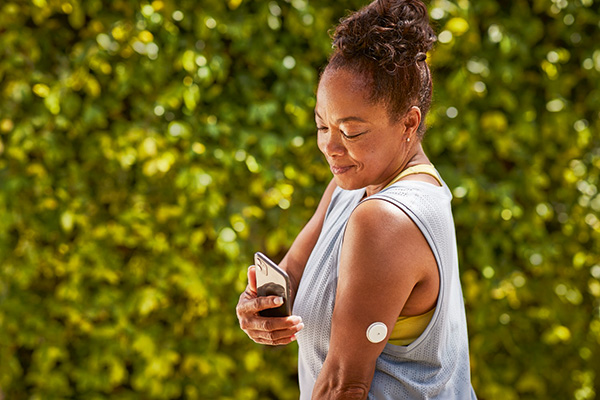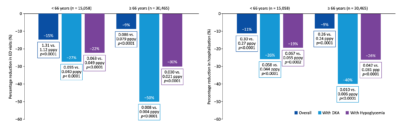Empowering Diabetes Management with Glucose Monitors

A new, first of its kind Canadian study suggests flash glucose monitors* can help improve health and reduce healthcare resource utilization (HRCU) for people living with diabetes.1
Presented at the American Diabetes Association’s (ADA) 84th Scientific Sessions this past June, findings from the FRONTIER study are significant, given that 5.8 million people in Canada live with diabetes.2 For many people living with diabetes, daily self-management of glucose levels is critical to reducing serious, potentially life-threatening complications that can lead to hospitalization.3,4 This means that beyond the physical and mental impacts on individuals, diabetes complications impose significant costs on an already stretched healthcare system. According to Diabetes Canada, the national cost of treating diabetes jumped from $14 billion in 2008 to just under $30 billion in 2019.5
Led by Dr. Stewart Harris and Dr. Alexandria Ratzki-Leewing of Western University, as well as Dr. Remi Rabasa-Lhoret of Université de Montréal, the FRONTIER study used data from the Institute for Clinical Evaluation Sciences (IC/ES) and real-world practice data, which were analyzed for more than 45,000 Ontarians diagnosed with type 1 or type 2 diabetes who met specific criteria.
“Our population-based study design allowed us to examine flash glucose monitor* use in a different way,” says Dr. Ratzki-Leewing. “For years, we’ve understood the benefits of this technology on diabetes management. The ability to study its effects on a much larger population, with a more comprehensive scope of people, helps validate that understanding and strengthen the case for the tool’s use by all people living with diabetes.”
The FRONTIER study examined two key measures: glycated hemoglobin (HbA1c) levels, an average of an individual’s glucose levels over a 2- to 3-month period, and healthcare resource utilization (HRCU), defined as the overall incidence of emergency department (ED) visits and hospitalizations. HbA1c levels were recorded 12 months before the first claim of a flash glucose monitoring system* and at the end of a 24-month follow-up period. HRCU data were collected from 12 months prior to the use of the technology and during the last 12 months of the follow-up period.1
As Harris, Ratzki-Leewing, Rabasa-Lhoret, and their colleagues found, the effect of flash glucose monitor* use on diabetes outcomes was undeniable. After adopting flash glucose monitoring*, HbA1c levels improved by 0.6 per cent for the under 66-year-old cohort and 0.3 per cent for the over 66-year-old cohort, regardless of their type of diabetes and treatment regimen (figure 1).1
Additionally, the overall incidence of ED visits dropped by 15 per cent for the under 66 cohort and 9 per cent for the over 66 cohort, whereas overall hospitalizations dropped by 11 per cent and 9 per cent, respectively, after using a flash glucose monitor* (figure 2).1

“These data give us proof that tools like flash glucose monitors* reduce healthcare utilization, support daily diabetes management and improve health outcomes,” says Dr. Harris. “For healthcare providers, like myself, it means having a tool to empower our patients to help control their glucose levels and reduce their risk of complications. And for our patients, it means having a companion that helps them make the hundreds of diabetes-related decisions they make every day.”
The results also clearly demonstrate the broad systemic benefits of flash glucose monitors*. Ontario is the first province to provide public coverage for flash glucose monitors* for people managing their diabetes with any insulin. Other provinces also offer reimbursement for these tools to individuals who meet specific criteria.††
“With more awareness, coupled with continually expanding reimbursement, Canadians, and the healthcare system, stand to benefit. Removing barriers to access is so important and it’s encouraging that many private and public reimbursement programs now cover flash glucose monitoring systems*,” adds Dr. Rabasa-Lhoret. “The evidence is clear – this technology supports people living with diabetes as well as the overall healthcare system.”
*Examples of flash glucose monitoring systems include Abbott’s FreeStyle Libre 2. The FreeStyle Libre 2 flash glucose monitoring system is indicated for measuring interstitial fluid glucose levels in people aged 4 years and older with diabetes mellitus. Always read and follow the label/insert. † Data collected from the FreeStyle Libre system. FreeStyle Libre 2 has the same features as the FreeStyle Libre system, with the addition of optional real-time glucose alarms. Study data are applicable to both products.
††Please check EasytoFreeStyle.ca for more information on public coverage in Canada for the FreeStyle Libre 2.
1. Harris, S.B., Ratzki-Leewing, A. et al. “FRONTIER – Flash Glucose Monitoring Use in Ontario Among Patients with DM in the ICES Database – Evidence from Real World Practice.” Data presented at the American Diabetes Association 84th Scientific Session, June 21-24, 2024. 2. Diabetes Canada. “Estimated Prevalence and Cost of Diabetes.” Accessed August 7, 2024. https://www.diabetes.ca/advocacy – policies/advocacy-reports/national-and-provincial-backgrounders/diabetes-in-canada 3. Benoit, Stephen R et al. “Trends in Emergency Department Visits and Inpatient Admissions for Hyperglycemic Crises in Adults With Diabetes in the U.S., 2006-2015.” Diabetes care vol. 43,5 (2020): 1057-1064. doi:10.2337/dc19-2449 4. McCoy RG, Lipska KJ, Van Houten HK, Shah ND. “Association of Cumulative Multimorbidity, Glycemic Control, and Medication Use With Hypoglycemia-Related Emergency Department Visits and Hospitalizations Among Adults With Diabetes.” JAMA Netw Open. 2020;3(1):e1919099. doi:10.1001/jamanetworkopen.2019.19099 5. Diabetes Canada. “New Data Shows Diabetes Rates And Economic Burden On Families Continue To Rise In Ontario” Accessed August 7, 2024. https://www.diabetes.ca/media-room/press-releases/new-data-shows-diabetes-rates-and-economic-burden-on-families-continue-to-rise-in-ontario.








